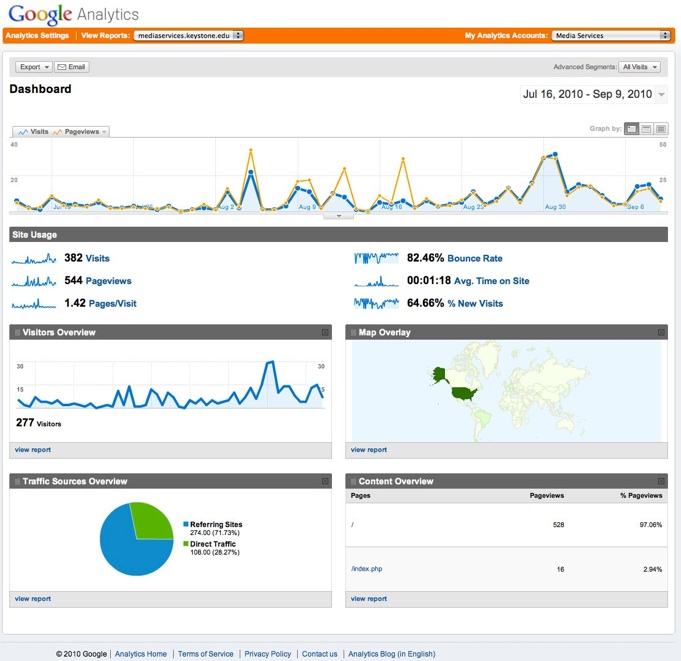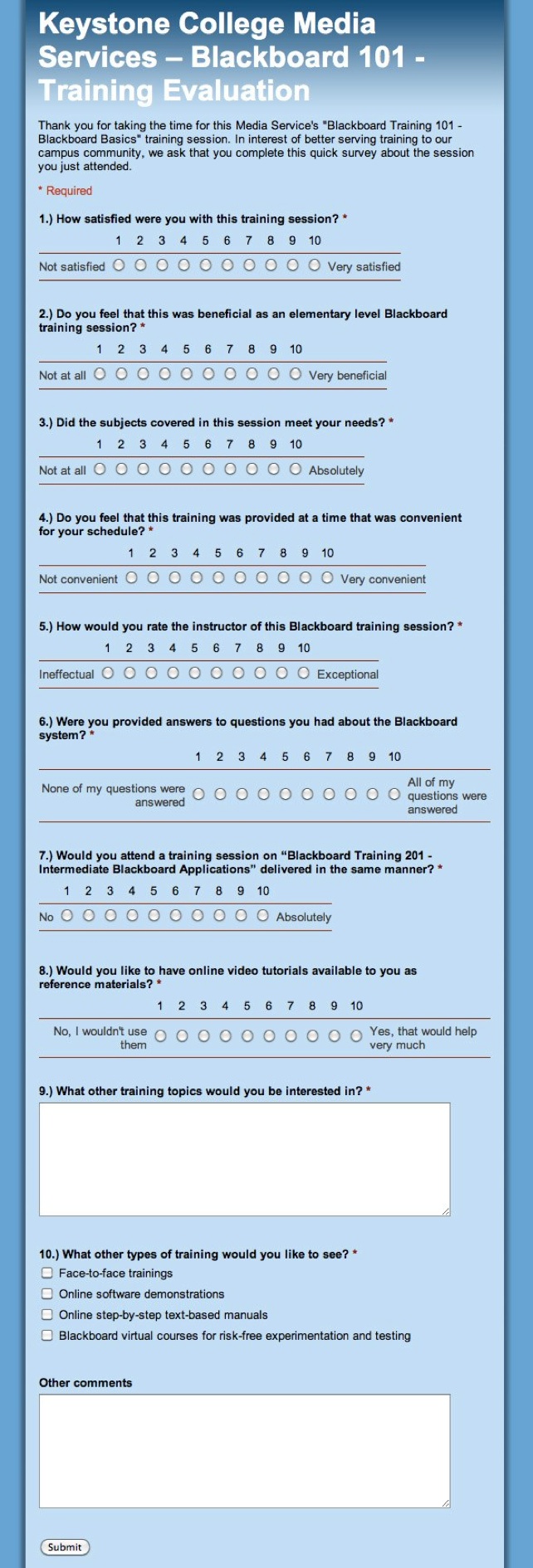Cycle 2 Data





Data
The Keystone College Media Services training website was again used as part of a two-week training exercise for our Blackboard LMS. The Cycle 2 training classes were delivered in two hour-long sessions on August 3rd and 5th. The first of these classes was designed for users whom had little to no experience with the Blackboard system. The second class taught more in-depth usage of the Blackboard system and built upon lessons from the first class. The first week of training had a group of six in attendance. The participants of the training enrolled in a virtual classroom in Blackboard and were asked to complete the lessons there. The lessons linked them to the appropriate video training on specific topics relating to the use of Blackboard. At the completion of each lesson the participants were asked to complete a ten-question satisfaction survey delivered as a link to a Google Form, which can be found here:
https://spreadsheets.google.com/viewform?hl=en&formkey=dElJZV9PdlRaYjV3WHF3Unk0VVBSVHc6MA#gid=0
The Media Services website’s traffic was again monitored throughout this cycle of the research using Google Analytics. Below is a sample page from the Google Analytics Dashboard. This displays the usage of the Media Services website from July 16th, 2010, through Sept 10th, 2010.
We can see the website usage had dwindled to an average of 3 hits per day prior to the start of the Cycle 2 research. On the first day of the training, we see the usage jumps from one visit to 11 visits and 16 viewed pages on the day of the August 3rd training. The next day the usage dropped to 2 visits and 3 page views. On August 5th, the second part of the training was held and the website reported 22 visits and 43 page views. For the remainder of the week the site had 18 visits, and 29 page views.
The second week of the training had two attendees and ran on August 10th and 12th. On the 10th there were 11 visits and 22 page views, segueing into 2 visits and 2 page views the following day. The second session on the 12th had 10 visits and 12 page views. The site then reports a slightly higher average use rate (approximately 7 visits per day) for the two-week period prior to the start of the fall semester. On August 30th, the first day of fall classes at Keystone College, the number of visits to the site jumped to 30 and held there an additional day before leveling off at an average of 9 visits per day for the next two weeks.
Insight
The results of the tracking information shows a steady increase in usage of the website in the weeks following the Cycle 2 training sessions. This usage continues to climb over the next two weeks, and then shows a large jump on the first day of classes. This could be due to several reasons:
1.)Instructors whom had participated in the Blackboard training sessions during Cycle 1 and 2 had informed their students about the resource.
2.)Students were visiting the site for tutorials regarding setting up their online accounts.
3.)Students were clicking the support link from within the Blackboard Learn system.
Now that there are more accessible links to the Media Services tutorial website from other systems on campus, the tracking information I am receiving is not solely the result of the controlled Blackboard trainings. Because the system was new to the school prior to the start of the AR project it was easy to surmise that all of the traffic to the site was from the training sessions. With more departments on campus adopting the system, and the site being utilized to address support tickets, I am unable to determine if the data received is from the training sessions or these other sources.
Surprises
I was very surprised to see these numbers nearly double the average on the first day of classes. This could be explained by new user exploration of the links from the support pages of the Blackboard system, or users legitimately using the system to learn about the technology on campus. As of yet I have not been able to develop the code that will allow me to track the individual tutorials viewed on the site, so there is no way of knowing the reasons that users were visiting the Media Services site.
The participants of the Blackboard training program were asked to take a ten-question survey at the conclusion of the session. There were eight participates in the training sessions conducted during my Cycle 2 research, however I only received feedback from one user. Their comments are listed below. Unfortunately, there were not enough survey results tabulated to gain a greater knowledge of how these trainings were received by the learners, but I am very pleased with the results of the site usage tracking software.
Below is a sample of the survey delivered using Google Forms.

Kassidy Evans
I am pleased to see the increase in activity as this research progresses. As a graduate of Keystone, I can say that Blackboard LMS is one of the most helpful tools that unfortunately, was used very infrequently. Little participation seemed to be caused by a technological gap, rather than lack of enthusiasm. As a student, it was readily apparent which instructors were employing Blackboard based on the "have to" verses the "know how".This would create many issues within the student/teacher realm of communication.By implementing these tutorials, it's clear that the Keystone community is responding positively, and reaping the benefits from the information provided. I am very happy to see that Justin has created a bridge to allow this system to be incorporated, and utilized in the manner it was initially intended.







Reactions from Critical Friends
Where do I go from here?
The next step for this project is populating the site with a full library of support tutorials addressing the needs of all technology support on campus. I would like these to include video trainings on classroom equipment, screen-capture tutorials on software and web applications, as well as links to other support websites. There is a very powerful free bulletin board software called pHpBB that I would like to incorporate into the site. This could be used to communicate information about new product features, conflicts, and known issues to the campus. The tracking data collection will also need to be fine tuned to more accurately depict which trainings are proving useful and which need to be redesigned. I hope that this system grows and develops it will be a valuable asset for our traditional and distance learning educational models.




